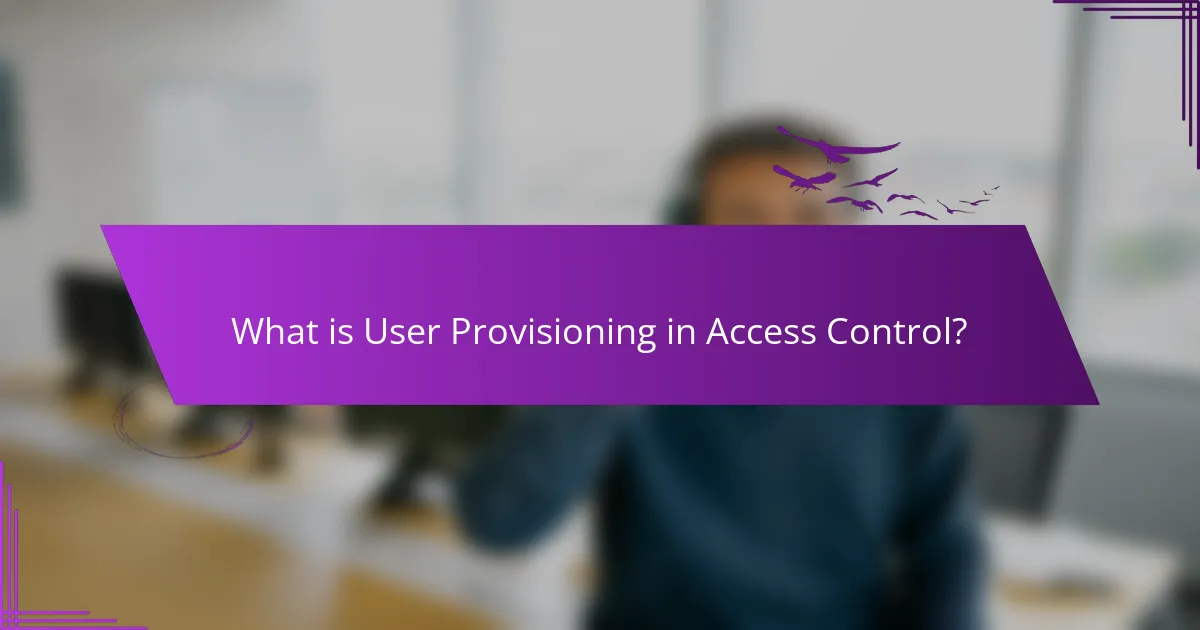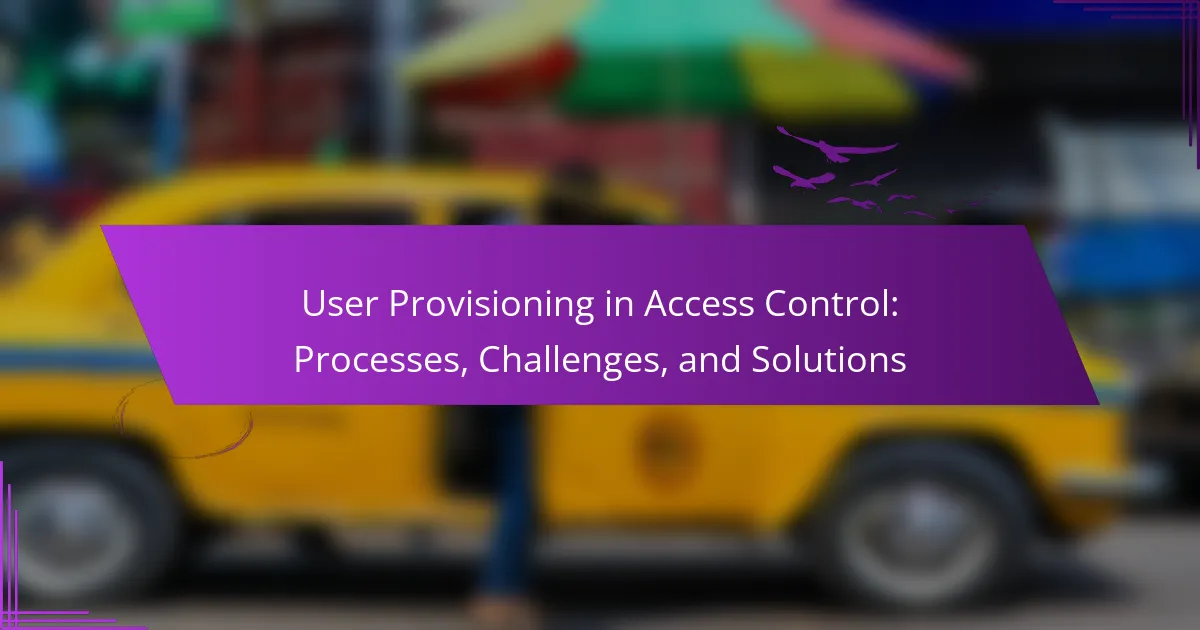
What is User Provisioning in Access Control?
User provisioning in access control refers to the process of creating, managing, and deleting user accounts and their access rights within a system. This process ensures that users have the appropriate level of access to resources based on their roles. User provisioning involves assigning roles, permissions, and credentials to users. It is essential for maintaining security and compliance within an organization. Effective user provisioning helps prevent unauthorized access and reduces the risk of data breaches. Organizations often use automated tools to streamline this process, ensuring efficiency and accuracy. According to a report by Gartner, organizations that implement automated user provisioning can reduce administrative costs by up to 30%.
How does User Provisioning fit into the broader context of Access Control?
User provisioning is a critical component of access control. It involves creating, managing, and deleting user accounts and permissions. This process ensures that users have the appropriate access levels based on their roles. Effective user provisioning enhances security by minimizing unauthorized access. It also streamlines user management and compliance with regulations. According to a study by Forrester Research, organizations with automated user provisioning experience 50% fewer security incidents. Thus, user provisioning directly supports the overall framework of access control by ensuring proper access management.
What are the key components of User Provisioning?
The key components of User Provisioning include user account creation, role assignment, access rights management, and de-provisioning. User account creation involves setting up new accounts in the system for individuals. Role assignment entails defining user roles that determine access levels and permissions. Access rights management is the process of granting or revoking permissions based on user roles. De-provisioning refers to the removal of user access when it is no longer needed. These components ensure that users have appropriate access to resources while maintaining security and compliance.
How does User Provisioning impact security and compliance?
User provisioning directly impacts security and compliance by managing user access to systems and data. Proper user provisioning ensures that only authorized individuals have access to sensitive information. This minimizes the risk of data breaches and insider threats. Compliance regulations often require strict access controls to protect sensitive data. For example, regulations like GDPR and HIPAA mandate that organizations implement adequate security measures. Failure to comply can result in hefty fines and legal repercussions. Additionally, automated user provisioning can streamline access management processes. This reduces human error and enhances security posture. Therefore, effective user provisioning is essential for maintaining security and meeting compliance standards.
What are the different types of User Provisioning?
There are several types of user provisioning. The main types include manual provisioning, automated provisioning, and self-service provisioning.
Manual provisioning requires administrators to create and manage user accounts directly. This method can be time-consuming and prone to human error. Automated provisioning uses software to streamline the process. It allows for bulk user creation and updates based on predefined rules. Self-service provisioning empowers users to manage their accounts. This can include password resets and profile updates without administrator intervention.
These types ensure that organizations can efficiently manage user access while adhering to security protocols.
How does manual provisioning differ from automated provisioning?
Manual provisioning involves human intervention to create and manage user accounts. This process is typically time-consuming and prone to errors. In contrast, automated provisioning uses software tools to streamline account creation and management. Automated systems can quickly handle large volumes of requests with minimal human oversight.
Research indicates that automated provisioning reduces onboarding time by up to 90% compared to manual methods. Furthermore, automated processes enhance security by minimizing the risk of human error. Thus, the primary difference lies in the involvement of human effort and the efficiency of the processes.
What role does role-based access control play in User Provisioning?
Role-based access control (RBAC) is essential in user provisioning as it governs user permissions based on their roles. RBAC streamlines the process of assigning access rights. It ensures that users receive only the permissions necessary for their job functions. This minimizes security risks by limiting access to sensitive information. RBAC enhances compliance with regulations by providing clear access controls. Additionally, it simplifies user management during onboarding and offboarding processes. By defining roles, organizations can efficiently manage user access across various systems. Therefore, RBAC plays a critical role in ensuring secure and efficient user provisioning.

What challenges are associated with User Provisioning?
User provisioning faces several challenges that can hinder effective access control. One major challenge is ensuring accurate user identity verification. Inaccurate data can lead to unauthorized access. Another challenge involves managing user roles and permissions effectively. Misconfigured roles can result in excessive privileges for users. Additionally, maintaining compliance with regulations is complex. Organizations must ensure that provisioning practices align with legal requirements. Furthermore, integrating user provisioning systems with existing IT infrastructure can be difficult. Compatibility issues may arise, leading to increased operational overhead. Finally, user provisioning processes can be time-consuming. Manual interventions often slow down the onboarding and offboarding of users. These challenges collectively impact the efficiency and security of user provisioning in access control systems.
What common issues arise during the User Provisioning process?
Common issues during the User Provisioning process include delays in account creation. These delays can occur due to manual processes or system integration failures. Inaccurate user data is another frequent problem. This can lead to incorrect access rights being assigned. Lack of standardization across systems often complicates the provisioning process. This inconsistency can result in security vulnerabilities. Additionally, insufficient training for administrators can lead to errors. These errors may further complicate user access management. Finally, failure to comply with regulatory requirements can pose significant risks. This can result in penalties or loss of data integrity.
How do human errors affect User Provisioning?
Human errors significantly impact user provisioning by introducing inaccuracies and inefficiencies in the process. These errors can lead to incorrect access rights being assigned to users. For example, a miscommunication during the onboarding process may result in a new employee not receiving necessary permissions. Additionally, human errors can cause delays in provisioning, which affects productivity. A study by the Ponemon Institute found that 60% of organizations experienced security breaches due to human mistakes. This statistic underscores the critical nature of accuracy in user provisioning. Furthermore, errors can lead to compliance issues, as incorrect access can violate regulatory standards. Overall, human errors in user provisioning compromise security and operational efficiency.
What are the risks of improper access management?
Improper access management poses significant security risks. It can lead to unauthorized data access, resulting in data breaches. According to a 2020 report by Verizon, 30% of data breaches involved internal actors. This can compromise sensitive information, leading to financial loss and reputational damage. Additionally, improper access can enable malicious activities, such as data theft or sabotage. Inadequate access controls can also result in non-compliance with regulations, incurring legal penalties. Furthermore, it can hinder operational efficiency by allowing unauthorized users to disrupt workflows. Overall, the risks of improper access management are critical and multifaceted.
How do organizations address these challenges?
Organizations address user provisioning challenges by implementing automated solutions. Automation streamlines the process of granting and revoking access. This reduces human error and ensures timely updates. Many organizations utilize identity and access management (IAM) systems. IAM systems centralize user data and control access permissions effectively. Organizations also adopt role-based access control (RBAC) to simplify user management. RBAC assigns permissions based on user roles, enhancing security. Regular audits and compliance checks further strengthen access control. These practices ensure that access rights align with organizational policies.
What best practices can be implemented to enhance User Provisioning?
Implementing best practices to enhance User Provisioning involves several key strategies. First, automate the provisioning process to reduce manual errors and speed up deployment. Automation tools can streamline user account creation, modification, and deactivation. Second, adopt role-based access control (RBAC) to ensure users receive appropriate permissions based on their job roles. RBAC simplifies management and improves security by limiting access to sensitive information.
Third, regularly review and audit user access rights. This practice can identify and remove unnecessary access, minimizing security risks. Fourth, implement a self-service portal for users to manage their accounts. A self-service option empowers users and reduces the administrative burden on IT teams.
Fifth, ensure compliance with organizational policies and regulatory requirements. Compliance helps maintain security standards and protects sensitive data. Lastly, provide ongoing training for users on security best practices. Educated users are less likely to fall victim to phishing attacks or other security threats. These practices collectively enhance the efficiency and security of User Provisioning processes.
How can technology solutions mitigate User Provisioning challenges?
Technology solutions can mitigate User Provisioning challenges by automating and streamlining user account management processes. Automation reduces manual errors and accelerates the onboarding and offboarding of users. Solutions like Identity and Access Management (IAM) systems centralize user data and access permissions. This centralization ensures consistent policy enforcement across platforms. Additionally, Single Sign-On (SSO) simplifies user access by allowing one set of credentials for multiple applications. Multi-Factor Authentication (MFA) enhances security during user provisioning by adding extra verification steps. According to a study by Gartner, organizations implementing IAM solutions can reduce user provisioning time by up to 80%. This efficiency leads to improved security and compliance, addressing common provisioning challenges effectively.

What solutions exist for effective User Provisioning?
Solutions for effective User Provisioning include automated provisioning systems and identity management platforms. Automated systems streamline the onboarding process for new users. They reduce manual errors and save time. Identity management platforms centralize user data and access rights. These platforms enable role-based access control. They ensure users have appropriate permissions based on their roles. Integration with existing systems enhances efficiency. Multi-factor authentication adds an extra layer of security. Regular audits of user access help maintain compliance. These solutions collectively improve security and operational efficiency in user provisioning.
What tools and technologies are available for User Provisioning?
User provisioning tools and technologies include Identity and Access Management (IAM) systems, Single Sign-On (SSO) solutions, and directory services. IAM systems like Okta and Microsoft Azure Active Directory manage user identities and access rights. SSO solutions, such as OneLogin, simplify user authentication across multiple applications. Directory services like LDAP and Active Directory store user data and facilitate access control. Automated provisioning tools, including SailPoint and Saviynt, streamline user onboarding and offboarding processes. These technologies enhance security and improve efficiency in user management.
How do Identity and Access Management (IAM) systems support User Provisioning?
Identity and Access Management (IAM) systems support User Provisioning by automating the process of creating, managing, and deleting user accounts. IAM systems streamline user onboarding by integrating with HR systems to provision accounts based on user roles. They enforce policies that ensure users receive appropriate access levels according to their job functions. IAM solutions also facilitate self-service capabilities, allowing users to request access and manage their profiles. Additionally, IAM systems provide audit trails and reporting features to track provisioning activities. This capability enhances security by ensuring that only authorized users have access to sensitive resources. Overall, IAM systems reduce administrative burdens and improve compliance with regulatory requirements.
What features should organizations look for in User Provisioning software?
Organizations should look for automation capabilities in User Provisioning software. Automation streamlines the user onboarding and offboarding processes. This reduces manual errors and saves time. Scalability is another essential feature. Scalable software grows with the organization’s needs. Integration with existing systems is crucial as well. Seamless integration enhances workflow efficiency. Security features, such as role-based access control, are vital. They ensure that users have appropriate access levels. Audit trails provide accountability and compliance tracking. This feature helps organizations meet regulatory requirements. User-friendly interfaces improve adoption rates among staff. Overall, these features significantly enhance user management efficiency.
What are the future trends in User Provisioning?
Future trends in user provisioning include automation, AI integration, and enhanced security protocols. Automation streamlines user account management processes, reducing manual errors and improving efficiency. AI integration enables intelligent decision-making in provisioning, allowing for adaptive access controls based on user behavior. Enhanced security protocols focus on zero trust models, ensuring strict verification at every access attempt. Additionally, real-time provisioning will become more prevalent, allowing users to gain immediate access to resources as needed. The trend towards self-service provisioning empowers users to manage their own access requests, further reducing administrative burdens. These trends reflect the growing need for agility and security in user access management.
How is automation shaping the future of User Provisioning?
Automation is significantly shaping the future of user provisioning by streamlining processes and enhancing efficiency. It reduces manual intervention in user account creation and management. Automation allows for real-time updates to user access based on role changes. This minimizes errors associated with manual processes. Additionally, automation enables organizations to enforce compliance with security policies consistently. Automated systems can quickly provision and deprovision users across multiple platforms. According to a study by Gartner, organizations implementing automated provisioning see a 50% reduction in time spent on user management tasks. This shift not only saves time but also improves overall security posture.
What role does artificial intelligence play in improving User Provisioning?
Artificial intelligence enhances user provisioning by automating and optimizing processes. AI algorithms analyze user data to streamline account creation and management. This reduces human error and accelerates onboarding times. Machine learning models can predict user needs based on historical data. This leads to more personalized access controls. Additionally, AI can monitor user activity for security compliance. By identifying anomalies, it helps in proactive risk management. Studies demonstrate that organizations using AI in provisioning see significant efficiency gains. For example, a report by Gartner indicates a 30% reduction in provisioning time with AI integration.
What are some practical tips for optimizing User Provisioning?
To optimize user provisioning, implement automated workflows for efficiency. Automation reduces manual errors and speeds up the process. Establish role-based access control to ensure users receive appropriate permissions. This method aligns access rights with job functions. Regularly review and audit user access to maintain security compliance. Conducting audits helps identify and remove unnecessary permissions. Utilize a centralized identity management system for streamlined user data management. Centralization enhances visibility and control over user accounts. Provide training for staff on user provisioning best practices. Educated personnel help minimize risks associated with access control.
User provisioning in access control refers to the systematic process of creating, managing, and deleting user accounts and their corresponding access rights within a system, ensuring appropriate access levels based on user roles. The article explores the critical components of user provisioning, including account creation, role assignment, and access rights management, while highlighting its impact on security and compliance. It addresses challenges such as human errors and improper access management, and outlines best practices and technological solutions that enhance the efficiency and security of user provisioning processes. Future trends, including automation and AI integration, are also discussed, emphasizing their role in optimizing user provisioning practices.
